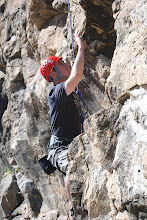Let me start this post by putting you in the right frame of shoe.
It's often a bit intimidating for new amputees to leave the safety (and fantastic bedside table service) of the hospital in order to venture home and begin adapting to independent life again. This is quite normal.
There's a LOT to figure out; how to carry a cup of coffee on crutches for example or how to go up and down a winding staircase. It takes practice to navigate the most familiar of environments, let alone one that's entirely foreign.
Now imagine what it's like to be asked to spend the night in a hotel room or someone else's home for the first time (post surgically). How about camping? In a tent? On the side of a rocky mountain somewhere?
Hey, no problem!
Those pesky midnight trips to the bathroom:In the past I tried traveling with collapsible hiking poles in lieu of crutches to get me around the room in the dark after I'd taken my leg off.
I thought it made sense; poles are light, compact and easy to pack in a suit case or strap to the outside of a backpack and might provide a little stability to my hopping in the middle of the night.
This proved to be quite dangerous. More than once, I very nearly took a header into the wall having a false sense of stability and the poles themselves would trip me up on unexpected lamps or desk chairs.
Solo hopping was no better and using a cane didn't work either. I didn't exactly have the best balance at 3am and the cardio woke me up a little too much.
I eventually came to the realization that, as much of a pain as it can be in the middle of the night, I just had to get used to putting that prosthesis on.
Do it a thousand times a day, in the dark, upside down in a tent, under water, in zero gravity and buried in a snowdrift until it becomes ultra-fast and completely second nature. It's really the best way to be safe and stable and let's face it, when you're camping you really don't have a choice.
I also find it helpful to keep a small flashlight/headlamp next to the bed. I'm less likely to run into an unexpected suitcase or lamp and the first few steps on a hastily donned leg aren't always completely stable.
Tricky shower configurations:The "lip" on the bottom of a shower door can be a real challenge. Sometimes it can be 6 inches high and made of brick, a difficult obstacle to shimmy over on a wet surface. Recessed showers are even worse.
Probably the easiest and safest method with any shower is to leave the leg on until the last minute. I release the suspension and keep my leg in the socket until I'm ready to step out of it, having used my good leg to step in to the shower stall or tub.

(click to enlarge)
Believe it or not, in all the assessments I had from care advisers, not a single person said "umm.. it's not hard dude, just keep your leg on until you're inside" so this was revolutionary to me when I figured out how to do it safely.
The real trouble comes when it's just not practical to do this. Sometimes a tub side is far too wide and the stance gets unsafe. Other times, having the leg that close to the water would mean all the fabric parts of my liner and suspension would get wet, making for an uncomfortable day.
Tub configurations with wide sides can be tricky but as long as it's easy to reach both tub sides without getting off balance, I can usually just sit on the edge and twist in.
The real trick comes in getting out when you're soaked. The sides can be treacherous and there's very little friction so using a few dry hair towels for grip is a handy trick.

(click to enlarge)
This still leaves recessed showers, large bricked in stalls (common in campgrounds & airports) and other tricky configurations where the liner or suspension would get wet.
To solve the problem, I use the desk chair from the hotel room and push that up to the shower door. I walk or crutch to the chair, sit down, put my crutches or prosthesis aside, place my foot inside the shower stall and stand up. Easy and safe.
So there you have it!
You really don't need anything special (mobility tools, shower aids, etc) when staying somewhere new. In fact, forming a reliance on them at home may cause stress when they're unavailable. Just arm yourself with a few extra ideas for adaptation and figure out what works for you.
Then again, maybe I'm the wrong person to ask about "disability aids". I like to believe that I could survive indefinitely, hundreds of miles from civilization (if such a place even exists anymore) with nothing but a makeshift knife and fantastic looking beard...
 After months of anticipation, seeking insurance approvals, going for fittings and taking cautious test flights indoors, I went for my first run in two years on Wednesday!
After months of anticipation, seeking insurance approvals, going for fittings and taking cautious test flights indoors, I went for my first run in two years on Wednesday!
















































